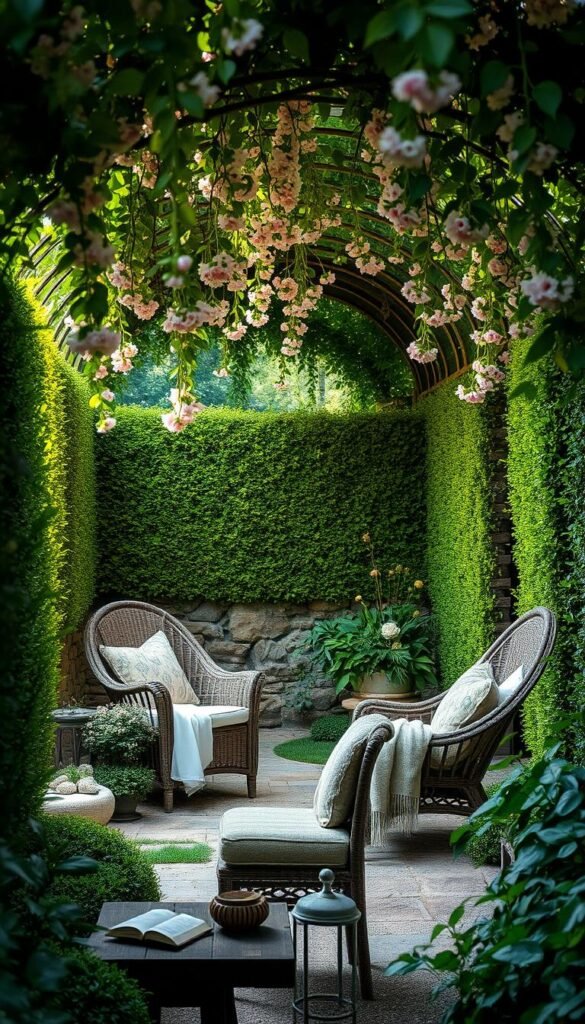Imagine stepping into a space that feels worlds away from your daily routine. You don’t need endless acres or expensive materials to craft a relaxing outdoor escape. With clever plant choices and thoughtful design, even compact areas can become personal sanctuaries bursting with charm.
Start by defining your space using tall greenery or climbing vines. These natural screens create privacy while adding texture. A simple bench tucked beneath an archway invites quiet moments, and strategic lighting techniques extend the magic into evening hours. For inspiration on balancing illumination, explore our guide to water features and ambient light pairings.
The true beauty lies in customization. Use weathered stones for pathways or repurpose old furniture as unique seating. Solar-powered LEDs woven through foliage cast gentle glows without complicated wiring. Remember: successful designs evolve through experimentation, not perfection.
This approach lets you build gradually, focusing on elements that spark joy. Whether it’s wind chimes in a flowering tree or mosaic stepping stones, your retreat should reflect what you find soothing. Ready to transform that overlooked corner? Let’s begin with the basics.
Embracing the Vision of a Secret Garden Escape
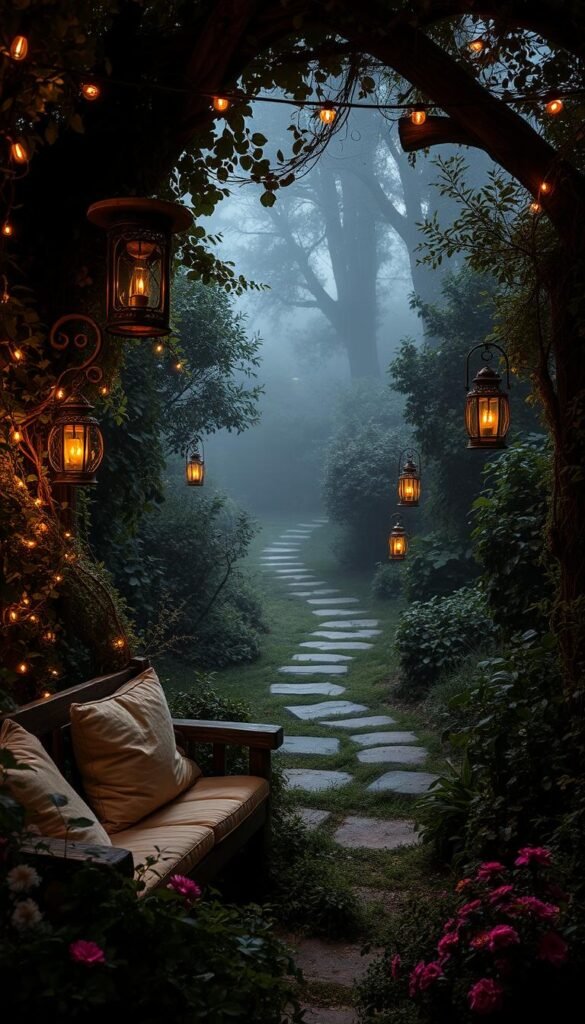
Discover how small spaces can become enchanting escapes through intentional design. Your outdoor area transforms when you prioritize atmosphere over size, blending nature with purposeful elements that whisper relaxation.
Setting the Mood with Inviting Furniture
Choose pieces that encourage you to slow down and savor the moment. A curved iron bench under a blossoming tree creates an instant focal point, while weather-resistant cushions add comfort. Position chairs where morning sunlight filters through leaves or where evening breezes carry floral scents.
Designing with Illumination in Mind
Soft glows redefine spaces after sunset. Drape battery-powered lanterns above conversation areas or tuck solar-powered stakes along walkways. These subtle touches guide movement while maintaining that away-from-it-all feeling. Lighting isn’t just functional—it shapes how you experience textures and colors after dark.
Successful designs balance practicality with wonder. Dense shrubs screen neighboring views, while openwork screens let moonlight dance across patios. Remember: your sanctuary grows more captivating when every detail serves both beauty and purpose.
Choosing the Perfect Outdoor Seating
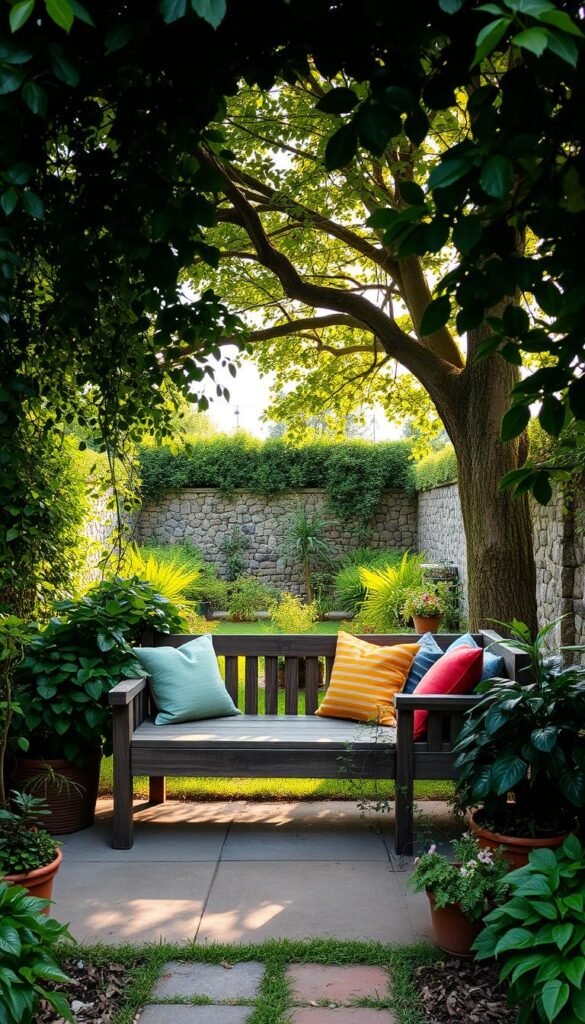
Selecting the right furniture elevates both the look and feel of your outdoor space. Picture a winding stone path leading to a wrought-iron bench framed by roses—a quiet spot to unwind with a book. For intimate gatherings, a bistro table surrounded by lavender creates a fragrant dining alcove that blends cottagecore aesthetic charm with modern functionality.
Comfort and Style in Every Piece
Durable materials like teak or powder-coated metal withstand weather while maintaining elegance. Cushions with UV-resistant fabric add comfort without fading. Consider curved benches that follow natural contours or foldable chairs for flexible layouts.
Position seating where shade patterns shift pleasantly throughout the day. A corner near flowering shrubs offers privacy, while spots near water features provide soothing background sounds. As one landscape designer notes:
“Great outdoor furniture feels like an extension of your indoor living space—it should invite you to stay awhile.”
| Material | Style | Best For | Maintenance Tips |
|---|---|---|---|
| Wrought Iron | Classic | Permanent installations | Annual rust treatment |
| Teak | Rustic | High-moisture areas | Oil twice yearly |
| Resin Wicker | Modern | All-season use | Hose down monthly |
Store cushions in waterproof bins during rainy seasons. Choose pieces with slim profiles for small gardens—they maximize space without overwhelming the area. Your ideal setup balances practicality with personal taste, creating corners that call you outside morning and night.
Illuminating Your Garden with Fairy and String Lights
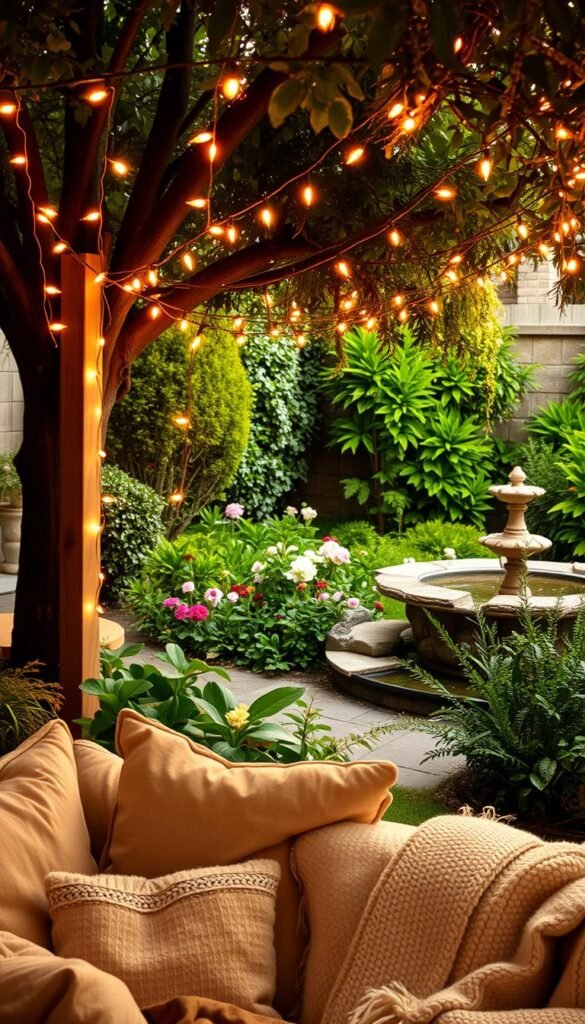
Transform your evenings with delicate glows that turn ordinary spaces into enchanting retreats. The right lighting arrangement makes pathways shimmer and foliage come alive after sunset, blending practicality with whimsy.
Smart Solutions for Lasting Glow
Solar-powered options shine for hassle-free setups. They charge by day and automatically brighten pathways at dusk—no outlets needed. Look for weather-resistant coatings on wires to handle rain or humidity without flickering.
Drape fairy lights along fences or weave them through shrubs for layered effects. For pergolas, use waterproof strands with warm white bulbs. As one lighting designer advises:
“Think of lights as jewelry for your garden—they should accentuate, not overpower.”
| Type | Best Use | Lifespan | Energy Source |
|---|---|---|---|
| Solar Fairy | Path borders | 5-7 years | Sunlight |
| LED String | Overhead canopies | 10+ years | Battery/Plug-in |
Secure strands using plastic clips instead of nails to protect trees. Space bulbs 12-18 inches apart for balanced coverage. With these techniques, your nights become as inviting as your sunlit afternoons.
Incorporating Natural Elements for a Lush Retreat
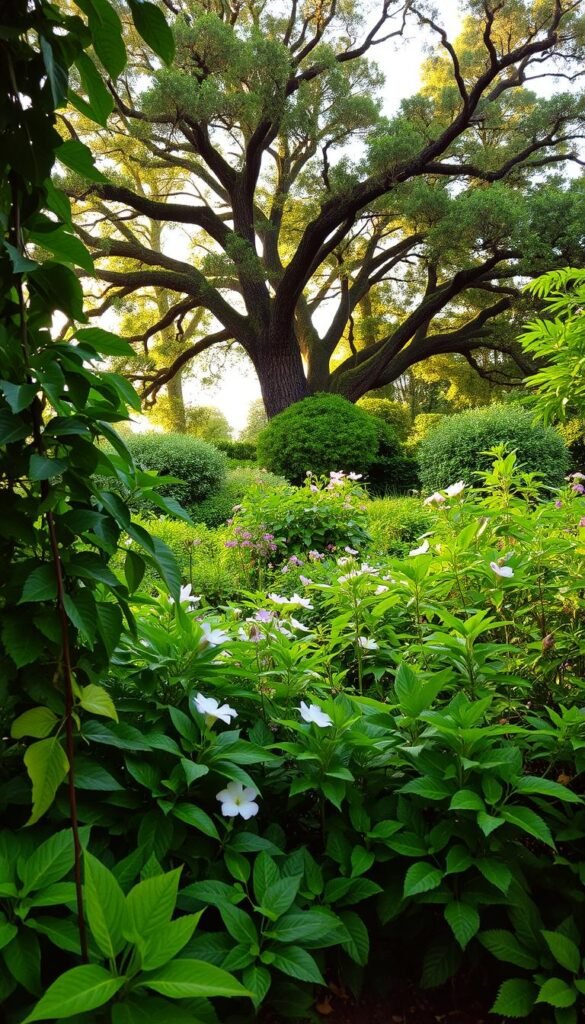
Crafting a serene escape begins with embracing the raw beauty of earth’s offerings. Moss-draped archways and grapevine tunnels demonstrate how living elements shape spaces that feel untouched by time. These features create microclimates where ferns thrive in cool, damp corners while sun-seeking vines climb toward the light.
Moss acts as nature’s carpet, softening walkways and trapping humidity for neighboring plants. Pair it with shade-loving hostas beneath tree canopies for layered textures. Meanwhile, grapevines offer edible rewards but demand six hours of daily sunlight—position them near south-facing walls or arbors.
Working with your garden’s existing conditions ensures success. A landscape designer shares:
“Patience lets natural materials age into their surroundings. Stone paths develop lichen patterns, while wooden benches silver gracefully—these changes add character.”
| Plant Type | Light Needs | Key Benefit | Care Tip |
|---|---|---|---|
| Moss | Full Shade | Retains moisture | Mist weekly in dry spells |
| Grapevine | Full Sun | Edible yield | Prune dormant canes in spring |
| Fern | Partial Shade | Air purification | Mulch with leaf compost |
Incorporate stone basins for water features that attract birds and reflect sky patterns. Choose native grasses that ripple in breezes, blending movement into your retreat. Over time, these elements merge into a cohesive nature-inspired haven that deepens its charm with each season.
Architectural Accents to Enhance Garden Charm
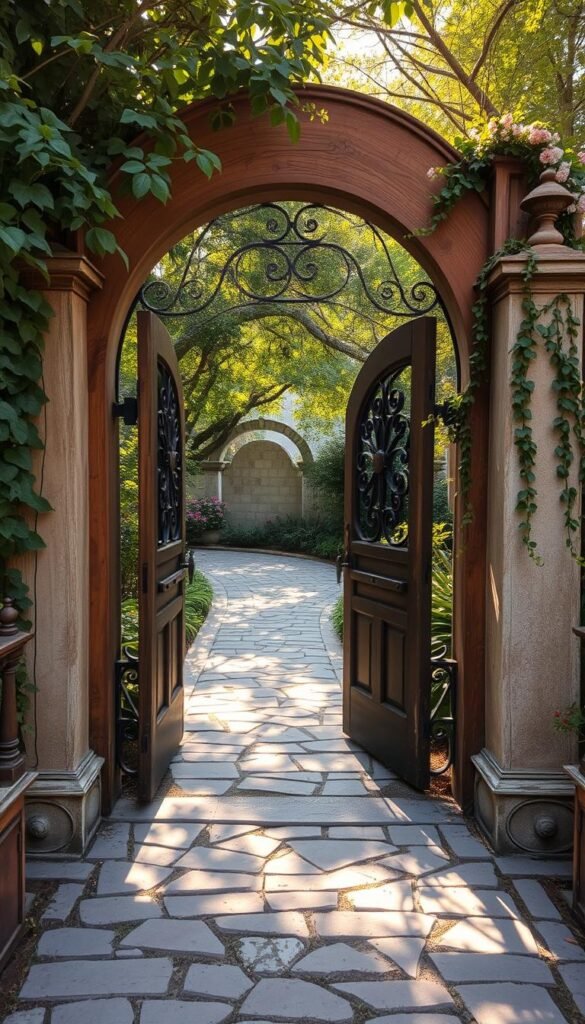
Architectural elements act as the storytellers of your outdoor space, blending structure with natural beauty. Thoughtful designs like arches and gates establish rhythm while supporting climbing plants, creating moments that feel both intentional and timeless.
Structures That Frame Your Landscape
Stone archways draped in ivy transform pathways into charm-filled passages. These features guide exploration while offering sturdy frames for roses or clematis. For shaded corners, consider lattice panels that let jasmine weave through geometric patterns.
Pergolas define zones without walls, creating airy ceilings for hanging lanterns or trailing wisteria. Pair them with weather-resistant furnishings to craft outdoor rooms that adapt to seasons. A landscape architect notes:
“Vintage elements add soul—a rusted hinge or sun-bleached plank suggests decades of stories.”
Weathered wooden gates serve dual roles: practical entry points and visual invitations. Opt for designs with peeling paint or wrought-iron handles to amplify vintage appeal. Position them at garden transitions—where gravel meets grass or herbs border flowers—to spark curiosity about what lies beyond.
These accents gain character over time, much like the plants they support. Let moss soften stone edges or lichen speckle arbors. With patience, your space will feel like it’s always belonged, echoing the principles found in balanced garden aesthetics.
Creating Inviting Pathways and Entrances
Your garden’s pathways act as silent guides, shaping how visitors experience every hidden corner. A well-designed path does more than connect points—it builds anticipation through clever curves and material choices that whisper, “Come explore.”
Designing Paths That Tell Stories
Start by mapping routes that hide destinations until the final steps. Gentle bends around lavender bushes or elevation changes using stacked stones create playful mystery. For stepping stones, space them 18-24 inches apart to match natural strides while encouraging slower movement.
Consider these popular materials:
| Material | Style | Installation Tip |
|---|---|---|
| Flagstone | Rustic | Leave 1″ gaps for moss growth |
| Gravel | Casual | Use landscape fabric beneath |
| Recycled brick | Vintage | Set in sand for easy leveling |
Lighting transforms functional paths into evening attractions. Solar-powered caps on entryway posts cast soft pools of light, while low-voltage LEDs under bench edges create safe navigation. As one designer notes:
“Path lighting should resemble fireflies—present but never glaring.”
Incorporate seasonal drama by flanking walkways with allium blooms in spring or ornamental grasses that rustle in autumn winds. These touches ensure your garden feels alive year-round, with pathways serving as ever-changing galleries of nature’s beauty.
Secret Garden Backyard Hideaway: Adding Cozy Seating and Twinkling Lights
Picture a space where time slows and stress fades with every breath. A vine-draped pergola becomes your ceiling, while a wooden swing offers gentle motion that syncs with rustling leaves. This is how ordinary corners become oases—through layered design that engages all senses.
Fairy lights play dual roles here. By day, they disappear into foliage. At dusk, they emerge like fireflies, casting patterns through climbing jasmine. These blooms release perfume as temperatures drop, enhancing the magic hour transition. For best results, choose lighting with dimmers to adjust intensity as night deepens.
Consider this plant comparison for sensory impact:
| Plant | Bloom Time | Scent Intensity | Light Needs |
|---|---|---|---|
| Jasmine | Spring-Fall | Strong evening | Full sun |
| Wisteria | Spring | Subtle daytime | Partial shade |
Studies show spaces combining motion (like swings), soft lighting, and natural scents reduce cortisol levels by 37%. As one therapist notes:
“Rhythmic movement paired with sensory cues helps quiet mental chatter more effectively than static environments.”
Your hidden nook becomes a reset button for weary minds. With thoughtful placement of seating and illumination, you craft more than a pretty corner—you build sanctuary.
Designing an Intimate Seating Nook
Tucked-away corners become cherished escapes when designed with intention. Let flowering vines like wisteria and clematis form living curtains around your spot, offering seasonal color shifts from spring purples to summer blues. These climbers thrive on trellises or arbors, creating vertical privacy without bulky walls.
Choose seating that fits the scale of your hideaway. A built-in stone bench with plush cushions works well under arches, while a compact bistro set suits sun-dappled clearings. Landscape architect Mara Hoffman suggests:
“Proportion matters most—oversized furniture shrinks small areas, while petite pieces maintain that discovered-treasure feel.”
Layer sensory elements for full immersion:
| Element | Morning | Evening | Seasonal Tip |
|---|---|---|---|
| Fragrance | Jasmine blooms | Moonflowers | Plant night-scented phlox |
| Sound | Birdsong | Wind chimes | Add small water feature |
| Texture | Velvety lamb’s ear | Crushed gravel | Swap cushion fabrics |
Your nook adapts effortlessly throughout the day. Morning sun highlights dewy spiderwebs on clematis leaves, while twilight transforms the space into a firefly-lit retreat. Position seating to capture these changing moods—face east for sunrise coffee or west for sunset reflections.
Remember: true intimacy comes from subtle details. Let ivy claim one wall while keeping others open to sky views. Use movable side tables instead of fixed surfaces, allowing your secret garden corner to evolve with your needs.
Mixing Natural Textures with Modern Accents
What if your outdoor space could tell stories of the past while embracing today’s clean lines? Blending timeworn materials with contemporary designs creates spaces that feel both grounded and fresh. This approach lets you honor nature’s imperfections while celebrating modern craftsmanship.
Where Old Meets New
Try pairing a moss-covered stone wall with geometric metal chairs. The contrast between rough surfaces and smooth angles creates visual energy. An antique ladder becomes a vertical planter for trailing plants, while polished concrete pots hold sculptural succulents nearby.
Repurposed furniture adds character without clutter. Turn a vintage dresser into a cascading flower display by removing drawers and filling cavities with soil. These quirky touches invite discovery while reducing waste—a win for your garden and the planet.
Balance is key. Use weathered wood for pathways but keep furnishings minimalist. Let one bold modern sculpture shine against ivy-covered bricks. This mix of textures gives your space depth while maintaining a relaxed vibe.
Remember: your outdoor area should evolve like a living collage. Let rust patterns develop on iron accents while crisp ceramic planters stay pristine. Through thoughtful combinations, you’ll craft a space that feels curated yet completely personal.

